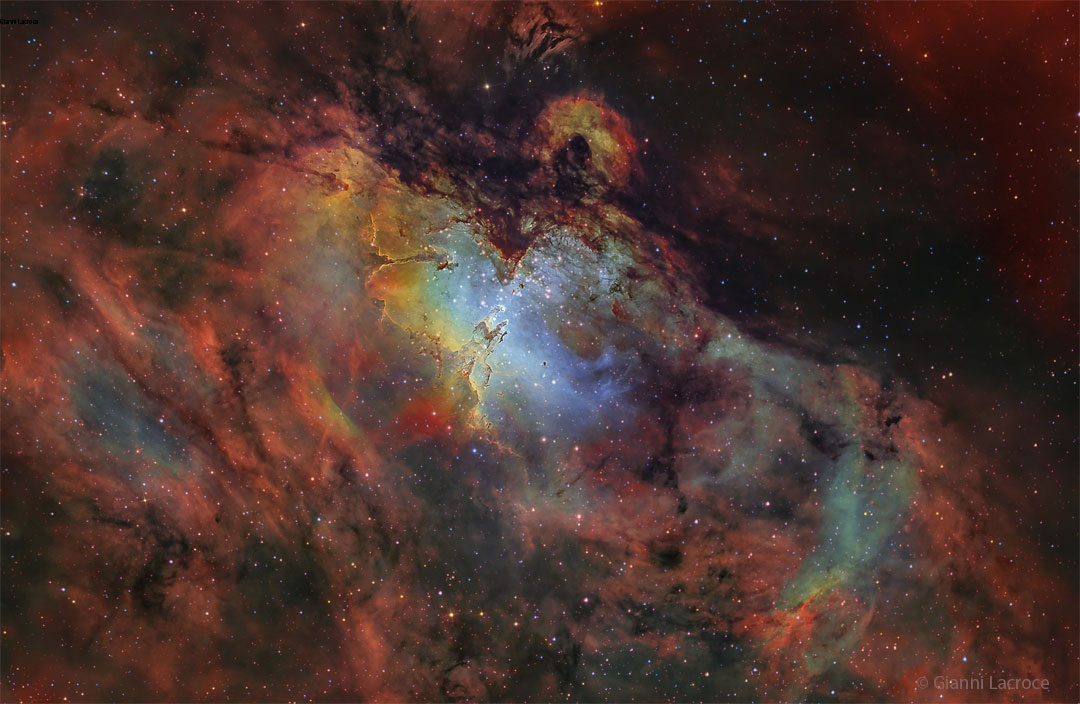15. May 2023
M16:鴟鴞星雲 ê 深空影像

探索宇宙1!逐工會揀一幅無仝款 ê 影像抑是相片,𤆬你熟似咱這个迷人 ê 宇宙,閣有專業天文學者2為你3解說4。
- 原始文章:M16: Eagle Nebula Deep Field
- 影像來源 kah 版權:Gianni Lacroce
- 台文翻譯:An-Li Tsai (NCU)
[漢羅] M16:鴟鴞星雲 ê 深空影像
咱若是 ùi 較遠 ê 所在看過去,就會看著這規个形體敢若是一隻 鴟鴞。 毋過咱若是搝近看這个 鴟鴞星雲,就會看著 較光 ê 部份 其實是大型烏暗 塗粉 殼 中央 ê 窗仔。 Ùi 這个窗仔,咱會看著一个去 hŏng 照予光 ê 工場,這其實是規个 開放星團 當 leh 形成新 ê 恆星。 Tī 這个空間內底,新 ê 恆星當咧形成,邊仔閣有 ùi 烏暗塗粉 kah 冷 分子氣體 中生出來 ê 懸懸 ê 雲柱 kah 圓圓 ê 雲球。 咱已經看會著幾若粒 leh 發藍光 ê 少年恆星,in 那燒那發出光、產生恆星風,kā tī 氣體塗粉內底做出來 ê 雲絲 kah 雲牆捒予開。 鴟鴞 發射星雲 ê 編號是 M16,就 tī 6500 光年 遠 ê 所在,大細差不多有 20 光年闊,用雙筒千里鏡 向 大隻蛇星座(巨蛇座)ê 方向就揣會著。 這張相片 是 長 時間感光 ê 深空影像,閣敆三種專有 ê 發射光:黃光 ê 硫磺、紅光 ê 水素、kah 藍光 ê 酸素。
[POJ] M16: Ba̍h-hio̍h-seng-hûn ê Chhim-khong iáⁿ-siōng
Lán nā-sī ùi khah hn̄g ê só͘-chāi khòaⁿ--khì, to̍h ē khòaⁿ-tio̍h che kui-ê hêng-thé ká-ná sī chi̍t-chiah ba̍h-hio̍h. M̄-koh lán nā-sī giú kūn khòaⁿ chit-ê Ba̍h-hio̍h-seng-hûn, to̍h ē khòaⁿ-tio̍h khah kng ê pō͘-hūn kî-si̍t sī tōa-hêng o͘-àm thô͘-hún-khak tiong-ng ê thang-á. Ùi chit-ê thang-á, lán ē khòaⁿ-tio̍h chit-ê khì hŏng chiò hō͘ kng ê kang-tiûⁿ, che kî-si̍t sī kui-ê khai-hòng-seng-thoân tng leh hêng-sêng sin ê hêng-chhiⁿ. Tī chit-ê khong-kan lāi-té, sin ê hêng-chhiⁿ tng leh hêng-sêng, piⁿ-á koh ū ùi o͘-àm thô͘-hún kah léng hun-chú-khì-thé tiong siⁿ--chhut-lâi ê koân-koân ê hûn-thiāu kah îⁿ-îⁿ ê hûn-kiû. Lán í-keng khòaⁿ-ē-tio̍h kúi-ā-lia̍p leh hoat nâ-kng ê siàu-liân hêng-chhiⁿ, in ná sio ná hoat-chhut kng, sán-seng hêng-chhiⁿ-hong, kā tī khì-thé thô͘-hún lāi-té chòe--chhut-lâi ê hûn-si kah hûn-chhiûⁿ sak hō͘ khui. Ba̍h-hio̍h hoat-siā-seng-hûn ê pian-hō sī M16, to̍h tī 6500 kng-nî hn̄g ê só͘-chāi, tōa-sè chha-put-to ū 20 kng-nî khoah, iōng siang-tâng chhian-lí-kiàⁿ hiòng tōa-chiah-chôa seng-chō (Kū-siâ-chō) ê hong-hiòng to̍h chhōe ē-tio̍h. Chit-tiuⁿ siòng-phìⁿ sī tn̂g sî-kan kám-kng ê chhim-khòng iáⁿ-siōng, koh kap saⁿ-chióng choan-iú ê hoat-siā-kng: n̄g-kng ê liû-hông, âng-kng ê chúi-sò͘, kah nâ-kng ê sàng-sò͘.
[KIP] M6: Ba̍h-hio̍h-sing-hûn ê Tshim-khong iánn-siōng
Lán nā-sī uì khah hn̄g ê sóo-tsāi khuànn--khì, to̍h ē khuànn-tio̍h tse kui-ê hîng-thé ká-ná sī tsi̍t-tsiah ba̍h-hio̍h. M̄-koh lán nā-sī giú kūn khuànn tsit-ê Ba̍h-hio̍h-sing-hûn, to̍h ē khuànn-tio̍h khah kng ê pōo-hūn kî-si̍t sī tuā-hîng oo-àm thôo-hún-khak tiong-ng ê thang-á. Uì tsit-ê thang-á, lán ē khuànn-tio̍h tsit-ê khì hŏng tsiò hōo kng ê kang-tiûnn, tse kî-si̍t sī kui-ê khai-hòng-sing-thuân tng leh hîng-sîng sin ê hîng-tshinn. Tī tsit-ê khong-kan lāi-té, sin ê hîng-tshinn tng leh hîng-sîng, pinn-á koh ū uì oo-àm thôo-hún kah líng hun-tsú-khì-thé tiong sinn--tshut-lâi ê kuân-kuân ê hûn-thiāu kah înn-înn ê hûn-kiû. Lán í-king khuànn-ē-tio̍h kuí-ā-lia̍p leh huat nâ-kng ê siàu-liân hîng-tshinn, in ná sio ná huat-tshut kng, sán-sing hîng-tshinn-hong, kā tī khì-thé thôo-hún lāi-té tsuè--tshut-lâi ê hûn-si kah hûn-tshiûnn sak hōo khui. Ba̍h-hio̍h huat-siā-sing-hûn ê pian-hō sī M6, to̍h tī 6500 kng-nî hn̄g ê sóo-tsāi, tuā-sè tsha-put-to ū 20 kng-nî khuah, iōng siang-tâng tshian-lí-kiànn hiòng tuā-tsiah-tsuâ sing-tsō (Kū-siâ-tsō) ê hong-hiòng to̍h tshuē ē-tio̍h. Tsit-tiunn siòng-phìnn sī tn̂g sî-kan kám-kng ê tshim-khòng iánn-siōng, koh kap sann-tsióng tsuan-iú ê huat-siā-kng: n̄g-kng ê liû-hông, âng-kng ê tsuí-sòo, kah nâ-kng ê sàng-sòo.
[English] M16: Eagle Nebula Deep Field
From afar, the whole thing looks like an eagle. A closer look at the Eagle Nebula, however, shows the bright region is actually a window into the center of a larger dark shell of dust. Through this window, a brightly-lit workshop appears where a whole open cluster of stars is being formed. In this cavity, tall pillars and round globules of dark dust and cold molecular gas remain where stars are still forming. Already visible are several young bright blue stars whose light and winds are burning away and pushing back the remaining filaments and walls of gas and dust. The Eagle emission nebula, tagged M16, lies about 6500 light years away, spans about 20 light-years, and is visible with binoculars toward the constellation of the Serpent (Serpens). This picture involved long and deep exposures and combined three specific emitted colors emitted by sulfur (colored as yellow), hydrogen (red), and oxygen (blue).
詞彙學習
| 漢羅 | POJ | KIP | 華語 | English |
|---|---|---|---|---|
| M16 | M cha̍p-la̍k | M tsa̍p-la̍k | M16 | M16 |
| 鴟鴞星雲 | Ba̍h-hio̍h-seng-hûn | Ba̍h-hio̍h-sing-hûn | 老鷹星雲 | Eagle Nebula |
| 開放星團 | khai-hòng-seng-thoân | khai-hòng-sing-thuân | 開放星團 | open cluster |
| 恆星風 | hêng-chhiⁿ-hong | hîng-tshinn-hong | 恆星風 | stellar wind |
| 雲絲 | hûn-si | hûn-si | 氣體絲 | filaments |
| 雲牆 | hûn-chhiûⁿ | hûn-tshiûnn | 氣體牆 | walls |
| 雙筒千里鏡 | siang-tâng chhian-lí-kiàⁿ | siang-tâng tshian-lí-kiànn | 雙筒望遠鏡 | binoculars |
| 巨蛇座 | Kū-siâ-chō | Kū-siâ-tsō | 巨蛇座 | Serpens |
| 硫磺 | lûi-hông | lûi-hông | 硫 | sulfur |
| 水素 | chúi-sò͘ | tsuí-sòo | 氫 | hydrogen |
| 酸素 | sàng-sò͘ | sàng-sòo | 氧 | oxygen |
| 分子氣體 | hun-chú-khì-thé | hun-tsú-khì-thé | 分子氣體 | molecular gas |
| 發射星雲 | hoat-siā-seng-hûn | huat-siā-sing-hûn | 發射星雲 | emission nebula |